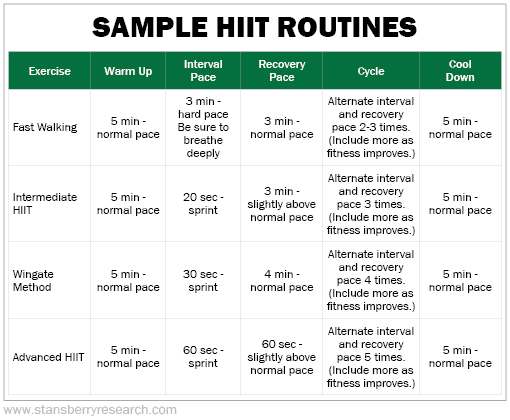Doc's note: We're closing out the week with the most challenging of my three favorite exercises...
On Monday, I explained why and how you were born to move, along with how to fulfill that destiny in the easiest possible way.
And yesterday, I raised the "difficulty level" bar a little higher with resistance training.
The exercise I'll talk about today requires you to go all out in effort, making it the toughest of the trio. But it's incredibly rewarding for your health – in the shortest time possible...

Today, I'm sharing one of my favorite ways to move. And it can help you accomplish your fitness goals quicker and with even greater benefits than other methods of working out...
It's called anaerobic exercise.
Anaerobic exercise is a form of movement that uses the body's energy stores (like blood sugar, or "glucose") to power working muscles without the use of oxygen. The term literally means without ("an") oxygen ("aerobic").
Research shows one form of anaerobic exercise is more effective than conventional strategies... and best of all, it only requires a minute or two a week...
I'm talking about high-intensity interval training ("HIIT").
Just like the name suggests, HIIT is a workout strategy where you mix short, vigorous bursts of movement with longer active-recovery periods (where you're still moving, but at a more relaxed pace). It's intense, but it's considered safe for all ages – even older folks and people just getting started with regular exercise.
In fact, if you watch the way small children run around and play – constantly moving at a slow to moderate pace, like a walk or a jog, and then suddenly getting a short burst of intense energy, like a sprint (and maybe even some giddy screaming) – you'll recognize that they're actually doing HIIT. We're naturally programmed to move this way.
It provides many great health benefits, including:
- Improving cardiovascular health (like lowering blood pressure)
- Building muscle tissue
- Increasing metabolism (which helps generate body heat)
- Increasing gastrointestinal transit speed (which reduces your risk of colon cancer)
- Easing arthritis
- Improving bone mineral density
- Reducing lower-back pain
And studies show HIIT is more efficient than regular aerobic exercise. It improves your body's ability to burn fat and calories. A 12- to 15-minute HIIT workout is equivalent to an hour of steady aerobic exercise.
That's because doing these short intervals tricks your body into thinking your heart is working at a higher rate for longer, so you get all the benefits of a much longer aerobic workout.
It works with activities like walking, running, swimming, cycling, and many more... Just find an activity you enjoy, and there's probably a way to create a HIIT version of it.
And here's the genius of HIIT...
According to additional research, reducing the intensity still provides benefits for people with somewhat limited mobility.
One study from McMaster University in Ontario, Canada showed that participants expended the most energy within the first 15 seconds of a single 30-second Wingate-method cycling sprint (followed by four minutes of rest and then repeated twice more, as shown in more detail on the chart below).
The key is to start at lower levels and build up slowly. If you're apprehensive, I'd recommend easing into it and fast walking for your first HIIT.
It's exactly like it sounds... You walk a few minutes to warm up, then walk fast for three minutes, then slow to a crawl, then walk fast again. (See the chart below for more details.)
Once you're ready for a more challenging workout, the next stage is an intermediate HIIT...
Here's what I do: I walk on a treadmill (or bike or aerobic-exercise contraption) at a slow pace to warm up. Then, I increase the pace to about 2.4 miles per hour (turtles crawl faster). Then, for 20 to 30 seconds, I crank it up to around 5 or 6 miles per hour or as fast as I can handle without falling all over myself. (Just make sure to be careful – again, the goal is not to hurt yourself.) I also do it with increased resistance by increasing the treadmill's incline to 3% or 4%.
That means I'm going at a fast pace at a hard resistance, but only for 30 seconds. Then, I slow down and do zero resistance for three or four minutes, and then repeat a couple more times. In 10 minutes, I'm done. I usually work up a nice sweat by the end.
You can see this routine – and some others, including a harder HIIT routine – in the table below...

While it is safe, HIIT – like any exercise program – does carry risks, especially if you're starting from a sedentary lifestyle. An Ironman athlete we spoke with (who uses HIIT for his training) suggested doing HIIT once or twice a week. This gives your body time to recover, so you can avoid injury.
Exercise is incredibly important to your health, and the sooner you start, the better. So do what I do and try a HIIT program. You can even start small by doing it just once or maybe twice a week for 30 to 60 seconds, maximum.
And if you enjoyed this article, you can get even more of my ways to enrich your health (and wealth) in my monthly Retirement Millionaire newsletter right here.
Here's to our health, wealth, and a great retirement,
Dr. David Eifrig and the Health & Wealth Bulletin Research Team
December 27, 2024
